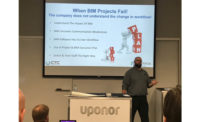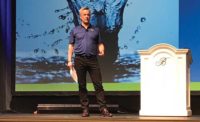Uponor hosted more than 40 engineers, contractors, reps and media members Sept. 11-12 at its Apple Valley, Minnesota headquarters for its 2018 Engineering Summit.
Bill Gray, Uponor’s North America president, opened the event saying the purpose of it was “to emphasize the value we place on stronger partnerships with engineers.”
Gray added: “Our objective is to meet the engineers’ needs to maximize system performance and meet project timelines, while articulating Uponor’s value to them in the form of lower installation and lifecycle costs.”
Robert Bean, P.E., and the director of Canada-based Indoor Climate Consultants, presented on how engineers should integrate the human sciences of thermal comfort, air and lighting quality within their HVAC designs. Each attendee received four Professional Development Hours after the presentation.
Bean noted that humans “judge buildings with our sensory systems.” Sound quality is the number-one complaint, according to a study Bean cited. He says that’s because buildings have shifted from using fabrics inside to more hard surfaces such as glass, steel and brick.
Indoor air quality used to be the top complaint, but has dropped to No. 3. Bean reminded attendees occupants aren’t always thinking about energy-efficiency, but if they don’t feel good inside the facility they will remember for a long time.
“Occupants don’t have energy problems, they have comfort problems,” he said.
Uponor Business Development Manager Devin Abellon, P.E., presented on commercial piping systems and stated from his discussions in the industry that “engineers are most concerned with system performance and reliability.”
He added: “Two independent studies showed they expect PEX to last more than 100 years under (the study’s) high-stress conditions.”
On Sept. 12, Don Rasmusson, the senior MEP application engineer with Bloomington, Minnesota-based CTC Design Software Solutions, spoke to attendees on integrated BIM design. He reminded listeners that “BIM is a workflow, not a software.”
Rasmusson also said engineers should seek out what he calls “high-value BIM tasks.”
“Those are tasks where you’re going to make money or not lose money,” he said.





